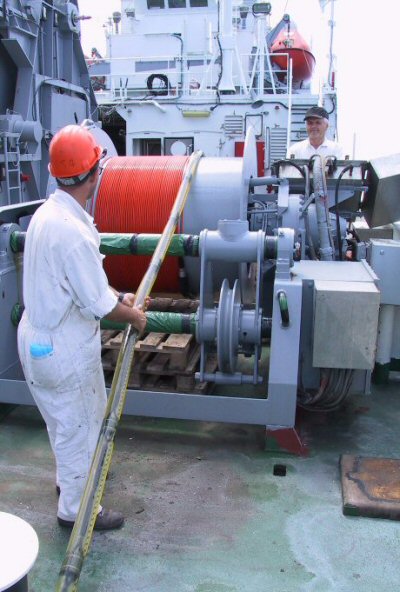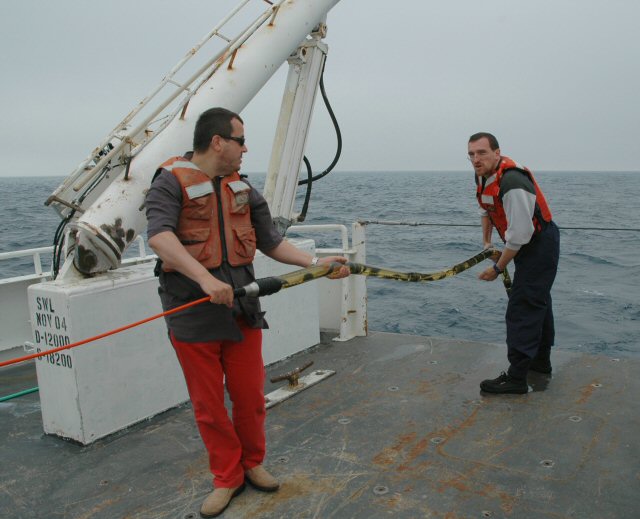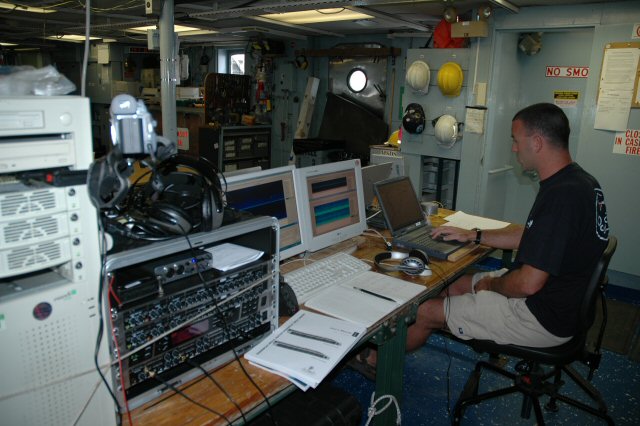
Università degli Studi di Pavia
Centro Interdisciplinare di Bioacustica e Ricerche Ambientali
Via Taramelli 24 - 27100 Pavia - Italye-mail : cibra@unipv.it
Acoustic Risk Mitigation Policies and tools to reduce the impact of anthropogenic noise on marine mammals
The concern that man-made acoustic signals can affect marine mammals has increased over the past few years, mainly within the context of low-frequency active sonars and seismic surveys. This topic has been extensively considered in many books and workshops, though, no definitive solutions to protect underwater life exist yet.
Mitigation policies developed, or being developed, by navies and civil companies, for example those developing sonars or performing geoseismic surveys with airguns, are mostly concerned to avoid exposing animals to sound pressures that could damage their hearing or disrupt their behaviour so much that their surivival could be threatened. This can be accomplished by 1) avoiding areas with high concentration of marine mammals, 2) by patrolling the chosen area to be sure there are no animals before starting sound diffusion, and 3) patrolling the area while producing sounds to be sure no animals are within or are approaching the high pressure sound exposure area.
The basic approach to accomplish these simple rules is to build databases to know the distribution of marine mammals' species, their feeding, reproductive and nursery areas, their migration routes and their critical habitats and habits. This could help in avoiding areas where it is most likely to find animals and to damage them.
A second required step is to implement all those techniques needed to detect the animals in an area: sighting them at the surface and listening to their underwater sounds are the two most used techniques. Though these techniques can fail: sightings can be done only in daylight with good weather conditions; listening to sounds can be done 24 hours a day, but requires suitable equipment. In any case, animals can be difficult to see, some specie can do long dives, up to 1 hour; or they can be silent, at least in the observation/listening period. Each technique has its own advantages and disadvantages, but a good integration of both seems to be the most successful solution to date. Trained marine mammal's observers (MMOs) and good acoustic equipment with trained acousticians can maximize the probability to detect marine mammals.
Whether it is in support of acoustic risk
mitigation measures, or in the larger context of
environmental monitoring, recent years have seen an
increasing use of underwater passive acoustics to detect
marine mammals.
Passive acoustic monitoring (PAM) is a powerful tool to be
used for (a) expanding knowledge about marine mammals’
behaviour, ecology and distribution; (b) monitoring
underwater noise; (d) monitoring critical habitats; (e)
evaluating the effects of sound exposure on animals’
behaviour; (f) implementing mitigation policies by
detecting animals within or approaching a possibly
dangerous sound exposure area. Moreover, acoustic contacts
can be recorded to provide a complete documentation about
detected animals.
CIBRA cooperated in the development of the NATO URC Marine
Mammals Risk Mitigation Policy (NATO URC STAFF INSTRUCTION
77-04), the related website,
and, more recently, of the Italian Navy Policy.
Cooperation in the implementation of the NMFS Policy
during seismic survey on the RV Maurice Ewing (Columbia
University / Lamont-Doherty Earth Observatory) allowed to
further raise our experience and capabilities in this very
new field.
CIBRA also works with ACCOBAMS to produce recommendations and guidelines for the Governments to reduce the impact on anthropogenic noise on marine mammals of the ACCOBAMS area. Two documents, requested by the ACCOBAMS Scientific Committee hase been produced so far:
Pavan G., 2005. Recommendations and guidelines to address the issue of the impact of anthropogenic noise on marine mammals in the Mediterranean Sea: toward a permit system for the ACCOBAMS area. Report prepared for the 3th ACCOBAMS Scientific Committee.
Pavan G., 2006. Guidelines to address the issue of the impact of anthropogenic noise on marine mammals in the ACCOBAMS area. Report prepared for the 4th ACCOBAMS Scientific Committee.
Reccomendation on anthropogenic noise
produced by the ACCOBAMS Scientific Committe.
Tools for mitigation
To support the Acoustic Risk Mitigation
Policies required or being developed by many national and
international civil and military organizations a PC based
PAM Digital Signal Processing Workstation (PAM DSPW or PAM
Workstation) was designed and extensively tested to
provide an affordable and flexible tool for wide band
acoustic detection and monitoring of marine mammals. It
provides acquisition, processing, storage and plotting
capabilities and can be used for both wide area surveys
and local monitoring needs. The ideal companion for the
DSPW is a set of PAM sensors that can be either stationary
hydrophones, sonobuoys or towed arrays of hydrophones.
In many years of extensive use it has been demonstrated
the importance of broadband detection, continuous 24/24h
monitoring and integration of visual cues to maximize
detection capabilities.
Other than state of the art signal acquisition and
processing hardware, the current PAM software package
includes custom software for 1) recording and analyzing
sounds received by up to 8 wide band sensors (up to 96 kHz
bandwidth; 1 channel up to 200 kHz bandwidth), 2) managing
a sonobuoys’ radio receiver, 3) recording, plotting and
distributing NMEA navigation data, 4) logging and
classification of acoustic contacts, 5) logging visual
contacts, 6) sharing data among a network of PCs either
wired or wireless, 7) plot georeferenced data on a GIS.
The oceanographic GIS, based on ESRI ArcView 8,
incorporates world-wide bathymetric data from GEBCO 1997
and the IBCM Mediterranean dataset.
A high-quality towed array designed for studying marine mammals sounds is the required complement for the PAM workstation. The array we own, designed in cooperation with Alenia in 1993, is still a reference for its wide bandwidth, low intrinsic noise and also for its reliability. New array design are now being experimented to improve localization capabilities while maintaining affordable both cost and complexity.
The PAM equipment has been used in cooperation with NURC in SIRENA cruises on the NRV Alliance, during NURC sonar trials and, in cooperation with Columbia University / Lamont-Doherty Earth Observatory, during seismic surveys (Holst et al., 2005) onboard the RV Maurice Ewing in the Atlantic and the Pacific Ocean. It has been also used in a number of other research cruises since 1991.
By participating in all these activities the CIBRA team has acquired a huge experience in using both visual and acoustic methods. Based on more than 15 years of experience, CIBRA can provide consultancy, specialized services and personnel to scientific, industrial and military institutions to setup their own experimental protocols, to design their instrumentation and to assist in the design and implementation of mitigation procedures to evaluate and reduce the impact of underwater noise on marine mammals
More details on the PAM equipment developed and used at CIBRA are available on the equipment development pages.

The CIBRA array on the winch of the NRV Alliance (SOLMAR Project)

The CIBRA array can deployed/recovered by hand (CEDAR 2005, RV Endeavour)

The CIBRA PAM Workstation in CEDAR 2005
Visual observation of marine mammals in a SIRENA cruise
References
AA.VV., 2003. Ocean noise and marine mammals. The
National Academies Press
Carron, M. 2004. NATO SACLANTCEN marine mammal risk mitigation programme (sound, ocean, and living marine resources). In Proceedings of the workshop on active sonar and cetaceans, pp. 59–62. Ed. By P. G. H. Evans and L. A. Miller. European Cetacean Society Newsletter No 42.
D’Amico A. (Ed.) 1998. Summary Record,
SACLANTCEN Bioacoustics Panel. La Spezia, Italy, 15-17
June 1998. Saclant Undersea Research Centre, M-133.
Gisiner R.(Editor), 1998. Proceedings of the workshop on
the effects of anthropogenic noise in the marine
environment. 10-12 February 1998, Office of Naval
Research, 141 pp.
Holst, M., M.A. Smultea, W.R. Koski, and B. Haley 2005.
Marine mammal and sea turtle monitoring during
Lamont-Doherty Earth Observatory’s marine seismic program
in the Eastern Tropical Pacific Ocean off Central America,
November–December 2004. LGL Rep. TA2822-30. Rep. from LGL
Ltd., King City, Ont., for Lamont-Doherty Earth
Observatory of Columbia Univ., Palisades, NY, and Nat.
Mar. Fish. Serv., Silver Spring, MD. 125 p.
McCarthy E., 2004. International Regulation
Of Underwater Sound: Establishing Rules And Standards To
Address Ocean Noise Pollution. Kluwer Academic Publ.:
287pp.
Merril J. (Ed.), 2004. Human-generated Ocean Sound and the
Effects on Marine Life. MTS Journal, Volume 37 (4), Winter
2003/2004.
Nascetti P., Perazzi A., Hastrup O. 1997.
An investigation of the interaction between active sonar
operations and marine mammals. European Research on
Cetaceans, 10: 61-67.
NATO URC HUMAN DIVER AND MARINE MAMMAL RISK MITIGATION
RULES. STAFF INSTRUCTION 77-04.
PAVAN G., FOSSATI C., MANGHI M., PRIANO M.,
2004. Passive acoustics tools for the implementation of
Acoustic Risk Mitigation Policies. In “Proceedings of the
workshop on Active sonar and cetaceans”, 17th ECS
Conference, March 2003, P. G. H. Evans and L. A. Miller
Eds., EUROPEAN CETACEAN SOCIETY NEWSLETTER NO. 42 –
SPECIAL ISSUE: 52-58.
PAVAN G., MANGHI M., 2004. Tools for underwater noise
monitoring, marine mammals’ surveys, and acoustic risk
mitigation policies’ implementation. Marine Mammals
Commission, USA. Published online http://www.mmc.gov
Richardson et al., 1995. Marine Mammals and Noise.
Academic Press
Richardson W.J., M. Holst, W.R. Koski, M.A. Smultea, M.
Rawson, 2004. Marine Mammal Monitoring and Mitigation
during Recent Seismic Surveys for Geophysical Research.
Marine Mammals Commission, USA. Published online
http://www.mmc.gov.
Simmonds et al. (Editors), 2004. Oceans of Noise. A WDCS Science Report: 1-168.
CIBRA Home Page
Updated July 2005